Walls surrounding the bathtub often go unnoticed, yet they hold incredible design potential that can redefine the entire look of your bathroom. Whether you’re working with a built-in tub or a freestanding style, the backdrop sets the tone for relaxation and style. From dramatic tile patterns and textured finishes to calming hues and practical storage solutions, the right wall treatment can bring both form and function to the space. As more homeowners seek bathrooms that feel custom and curated, tub wall ideas are gaining traction for their impact. This post covers standout solutions that add depth, style, and utility to any bathroom.
Tile Drenching with Matte Finishes
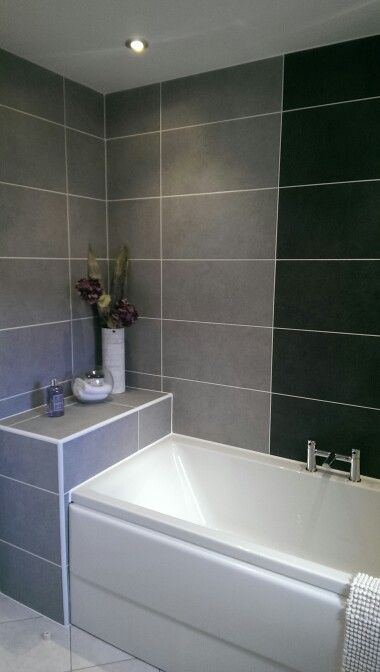
Surrounding the entire tub zone in matte tiles delivers a cohesive, spa-like environment that feels grounded and modern. These finishes absorb rather than reflect light, resulting in a softer visual impact that pairs well with muted tones or earthy palettes. Matte surfaces also conceal fingerprints and water spots better than glossy alternatives, offering practical benefits alongside their aesthetic appeal. From porcelain to cement-inspired ceramic, tile drenching ensures durability without compromising on style. To keep the space from feeling flat, consider subtle variations in tone or shape. Hexagons, vertical rectangles, or Moroccan fish scale patterns can provide depth. This method works especially well in contemporary and Japandi-style bathrooms, where visual simplicity reigns. Floor-to-ceiling coverage creates the illusion of higher ceilings and adds visual continuity. For best results, ensure the grout color matches the tile closely, reinforcing the seamless flow. Matte finishes bring understated luxury right to the heart of your tub zone.
Integrated Storage Niches
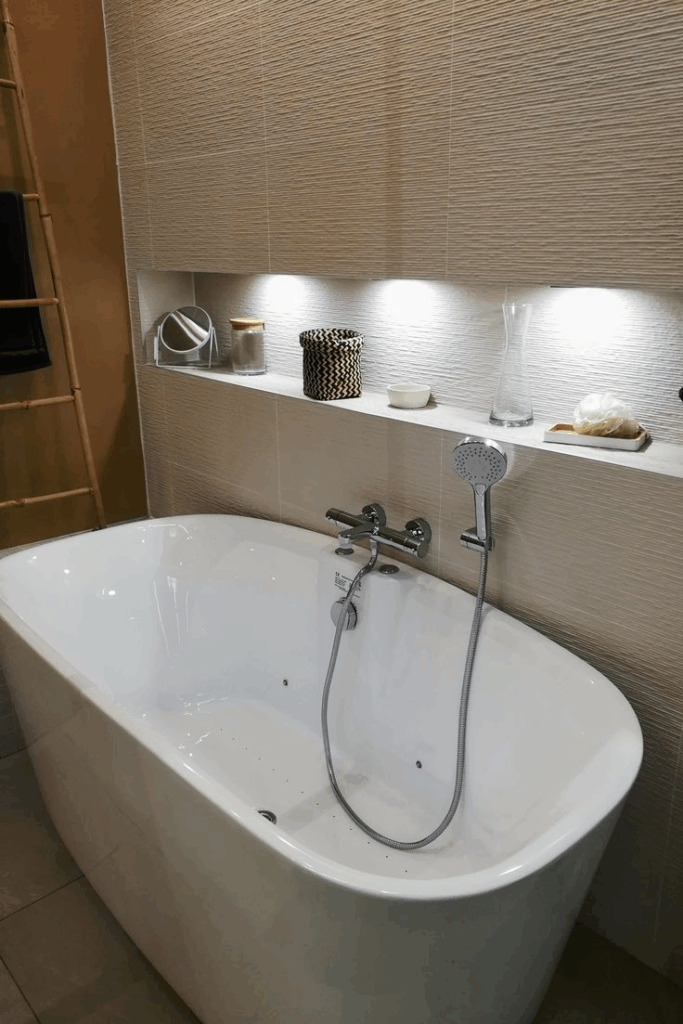
Built-in wall niches are a sleek solution for storing bath essentials without interrupting design flow. By embedding these spaces directly into tub walls, visual clutter is minimized and shelving becomes part of the architecture. Rectangular or arched formats work well, and the interior can feature accent tiles or contrasting finishes for added personality. Niches positioned at arm’s reach keep soap, shampoos, and candles within easy access while eliminating the need for hanging baskets or corner shelves. In minimalist or modern bathrooms, they maintain clean lines while serving a vital storage purpose. Consider LED strips inside the niche to add ambient lighting and highlight decorative pieces. For durability, opt for water-resistant tile and proper waterproofing membranes to ensure longevity. When aligned with grout lines or centered along the tub wall, niches contribute to a more curated and custom-built look. Their seamless integration proves that functionality doesn’t have to disrupt style.
Natural Stone Accents
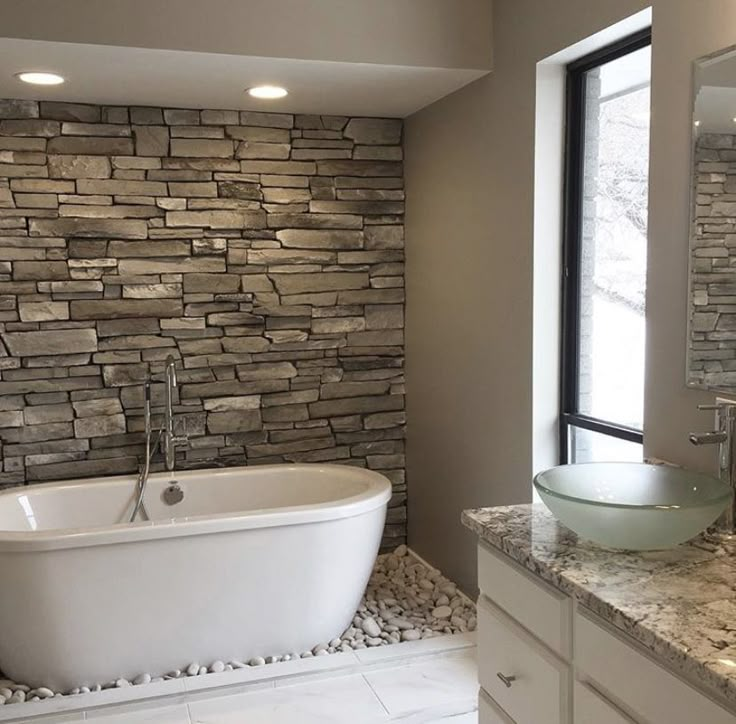
Stone around the tub wall introduces raw texture and organic charm that’s impossible to replicate with synthetic materials. Whether it’s honed travertine, veined marble, or stacked slate, each stone type brings its own unique grain, color variation, and natural warmth. Used as a partial wall accent or full surround, it immediately elevates the bathroom to a more luxurious tier. Stone is best suited for moisture-prone areas when sealed properly and installed with professional-grade waterproofing techniques. Pairing stone with minimalist fixtures, such as matte black taps or frameless glass, creates a balanced design that feels both grounded and elevated. In rustic, farmhouse, or biophilic-inspired spaces, natural stone becomes a tactile focal point. To avoid overwhelming the room, opt for one stone feature wall behind the tub and keep surrounding areas simple. This allows the texture and depth of the material to truly stand out without overpowering the layout.
Vertical Wood Slat Panels
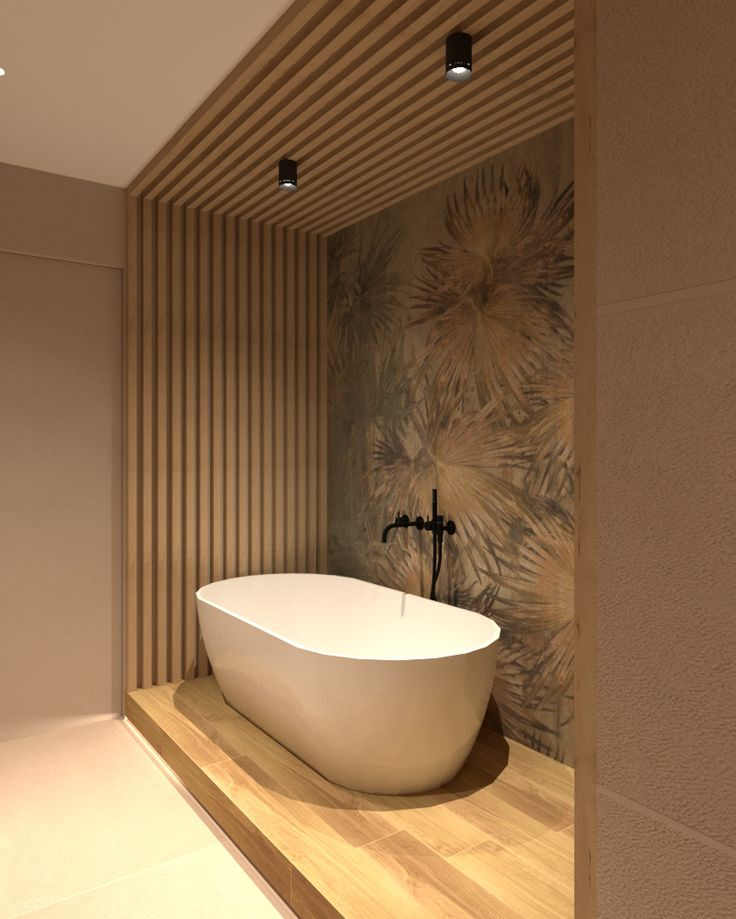
Linear wood slats deliver a warm, architectural element that wraps the tub wall in texture without overwhelming the space. By running vertically, these panels draw the eye upward, making bathrooms feel taller and more open. Moisture-resistant hardwoods like teak or thermally treated oak are ideal choices, as they resist warping and add longevity to the feature. To maintain airflow and durability, slats should be spaced evenly and installed with water-sealing finishes. When paired with matte tiles or stone flooring, the slatted wall adds contrast through natural grain and rhythmic repetition. Ideal for Scandi, Japandi, or organic modern aesthetics, wood slats soften hard surfaces and introduce a calming visual texture. Some homeowners choose to frame the tub zone entirely with these panels, while others prefer a half-wall feature that doubles as a backdrop for a freestanding tub. Either way, the result is a bathroom with warmth, movement, and undeniable style.
Backlit Wall Features
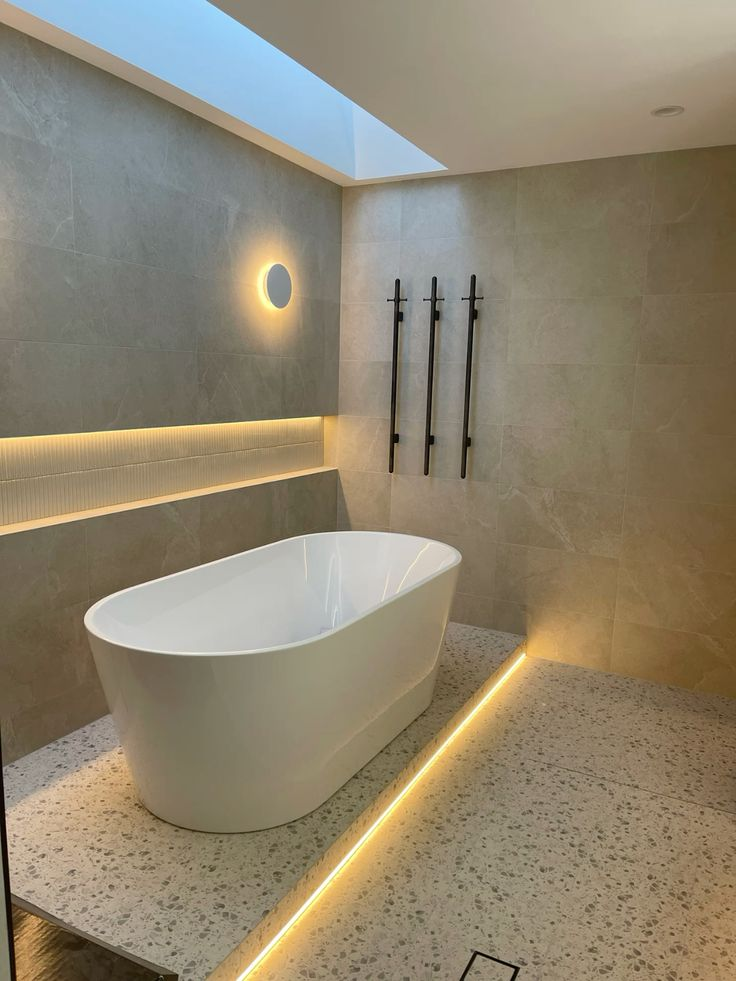
Lighting behind the tub wall is more than a luxury—it’s a powerful mood-setting element that turns routine baths into atmospheric retreats. Backlit panels, especially when diffused behind textured tiles or frosted glass, cast a soft glow that eliminates harsh shadows and highlights architectural features. LED strips concealed behind floating slabs, decorative cutouts, or shelving niches add depth and drama to the tub zone. This setup works beautifully in minimalist bathrooms where ambient lighting can become the star without needing elaborate fixtures. When installed with dimmers, the light intensity can shift from functional to soothing, adapting to time of day or mood. Cool-white tones give a clean, modern edge, while warm-white adds coziness and spa vibes. To maintain safety and longevity, ensure lighting elements are waterproof and rated for wet environments. This modern lighting approach makes the space feel more custom, thoughtful, and designed for complete relaxation.
Mixed Material Combinations
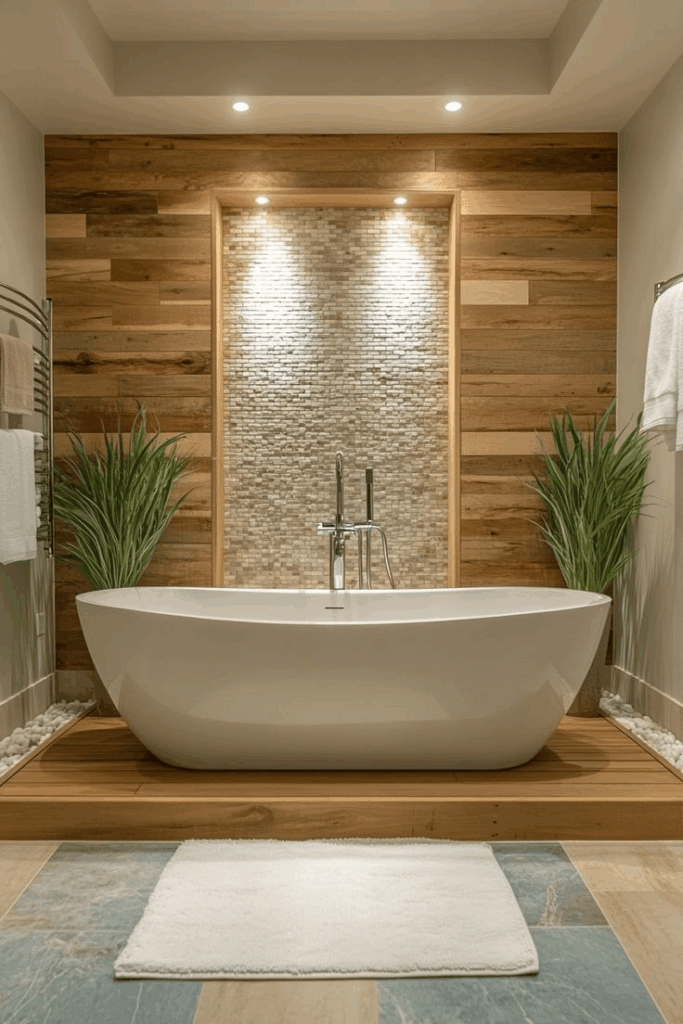
Balancing texture and tone through carefully selected materials can dramatically change the perception of a tub wall. Think marble paired with raw concrete, zellige tiles juxtaposed against wood slats, or smooth plaster framing sections of rough-cut stone. These combinations add depth without clutter and invite the eye to explore. The key lies in selecting materials with complementary tones but varying finishes—matte, glossy, porous, and polished. For example, pairing tumbled limestone with sleek porcelain tiles creates visual tension that feels curated and intentional. Mixed materials also allow for natural zoning, such as using tile near high-moisture areas and wood or plaster further away. This strategy suits eclectic, transitional, or modern rustic bathrooms where contrast is celebrated. Cohesiveness can be achieved through repeating elements like a unified grout color or matching hardware finishes. Material contrast should feel like a conversation, not a clash—each element contributing to a unified design narrative around the bathtub.
Statement Wallpaper
Wallpaper brings instant impact to a tub wall without requiring complex installations or permanent finishes. Moisture-resistant and vinyl-backed options now allow for placement in splash zones, making it feasible to use bold prints behind freestanding tubs. From oversized florals and jungle scenes to abstract geometrics and metallic textures, wallpaper introduces personality and drama in a way few other materials can. When carefully selected, it sets the entire tone of the bathroom—whether that’s moody, playful, or serene. For small spaces, try large-scale patterns to create an illusion of expansion. Wallpaper also works beautifully when framed with tile borders or placed above a tiled wainscot. It’s crucial to use water-resistant adhesives and professional-grade sealing to protect from steam and splashes. For renters or those seeking easy updates, peel-and-stick options deliver flexibility without commitment. This design move ensures the tub wall becomes an eye-catching canvas that reflects personal taste and trend-forward thinking.
Floating Shelves
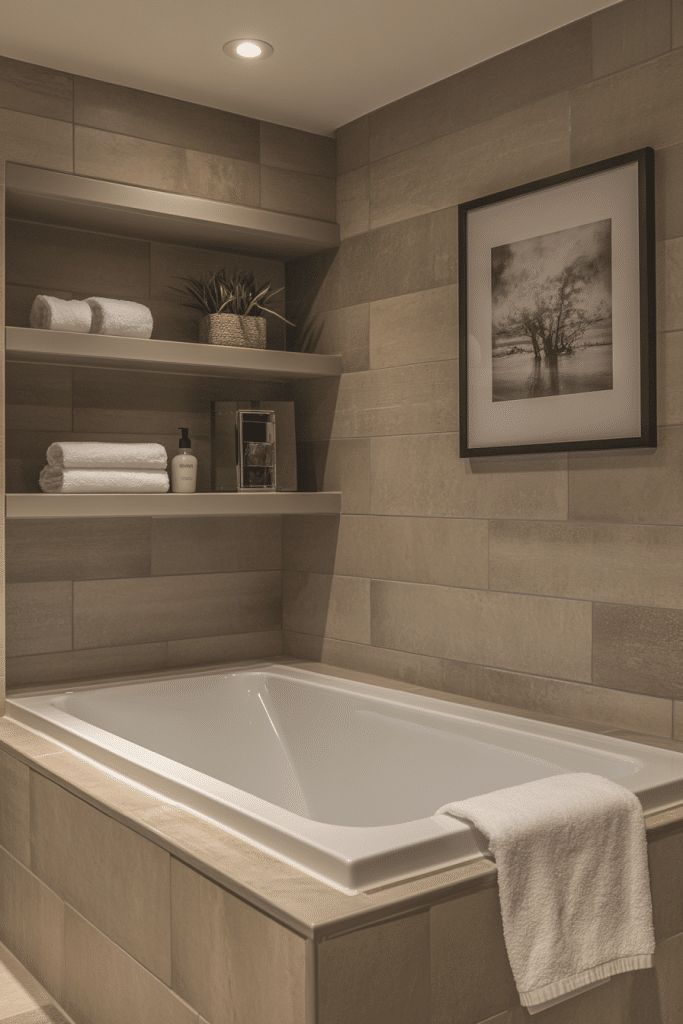
Installing slim, floating shelves above or around the tub area offers a stylish way to introduce both storage and display. Unlike bulky cabinetry, floating shelves maintain visual openness while giving bathers easy access to essentials like candles, salts, or skincare. Natural wood tones add warmth, while glass or metal options suit sleeker spaces. Shelves can run horizontally across the tub wall or be stacked vertically for a column effect. Styling matters here—balance functional items with decorative pieces like small potted plants, framed art, or neatly rolled towels. In minimalist bathrooms, keeping shelf contents minimal reinforces clean design lines. To ensure safety and longevity, choose moisture-resistant materials and anchor securely into studs or waterproof wall anchors. When aligned with other architectural lines in the bathroom, floating shelves feel integrated rather than added on. They offer the perfect balance of form and function while elevating the tub zone’s practical charm.
Artistic Wall Murals
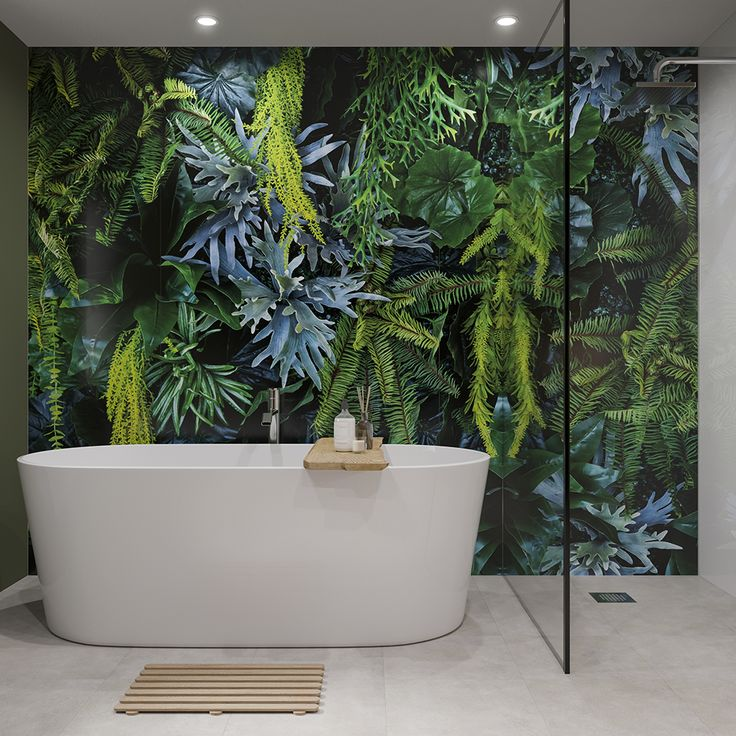
Visual storytelling around the tub area offers an immersive experience, and custom or peel-and-stick wall murals make that possible without tiling every inch. Whether depicting tranquil landscapes, abstract color flows, or ocean-inspired scenes, murals draw the eye and create a sense of escape. They’re particularly effective behind freestanding tubs, where the wall becomes a canvas rather than just a background. Waterproof mural options and proper sealants ensure they withstand the bathroom’s humidity and daily wear. In modern homes, digitally printed designs allow for personalization—nature photography, minimalist line art, or even vintage motifs can be applied. Using a mural strategically on just one wall enhances depth and dimension without overwhelming the space. To keep the design balanced, coordinate nearby accessories with colors from the mural. From subtle tones to dramatic visuals, this technique gives the bathroom individuality and soul, turning a simple tub corner into a piece of functional art.
Textured Wall Panels

Depth and dimension can be achieved instantly with wall panels featuring ridges, grooves, or wave-like contours. These tactile surfaces introduce shadow play that changes throughout the day, depending on lighting and viewing angle. Made from materials like 3D-printed polymer, wood composite, or moisture-resistant MDF, textured panels now come in bathroom-safe formats. Installation is relatively straightforward and can be done across the full tub wall or in framed sections as accent art. For neutral color palettes, panels break the monotony without the need for vibrant hues. In more dynamic bathrooms, painting these panels in bold tones adds an unexpected pop. Easy to clean and maintain, especially when sealed, they offer a low-maintenance upgrade that feels high-design. Curved wave textures are perfect for spa-inspired settings, while angular lines suit more modern, geometric bathrooms. With these panels in place, the bathtub wall becomes not just a utility surface, but a sensory statement.
Glass Mosaic Tiles

Color, shine, and intricate detail come together through the use of glass mosaic tiles on the tub wall. These small tiles—available in sheets or custom patterns—bring shimmer and light play into the room, making them ideal for areas with low natural light. Their reflective nature bounces light around the space, giving a bright and polished appearance even in compact bathrooms. Mosaics work beautifully in accent sections, such as recessed niches or borders, but can also cover full walls for a jewel-box effect. Blues, greens, and metallics are common for achieving spa-like vibes, while monochromes suit sleek, contemporary looks. Installation requires precision and high-quality grout, as the density of grout lines adds to the overall visual texture. Despite their delicate look, glass mosaics are highly durable and resistant to water, making them suitable for direct splash zones. This artistic approach brings vibrancy and craftsmanship into one of the bathroom’s most visible surfaces.
Industrial Metal Accents
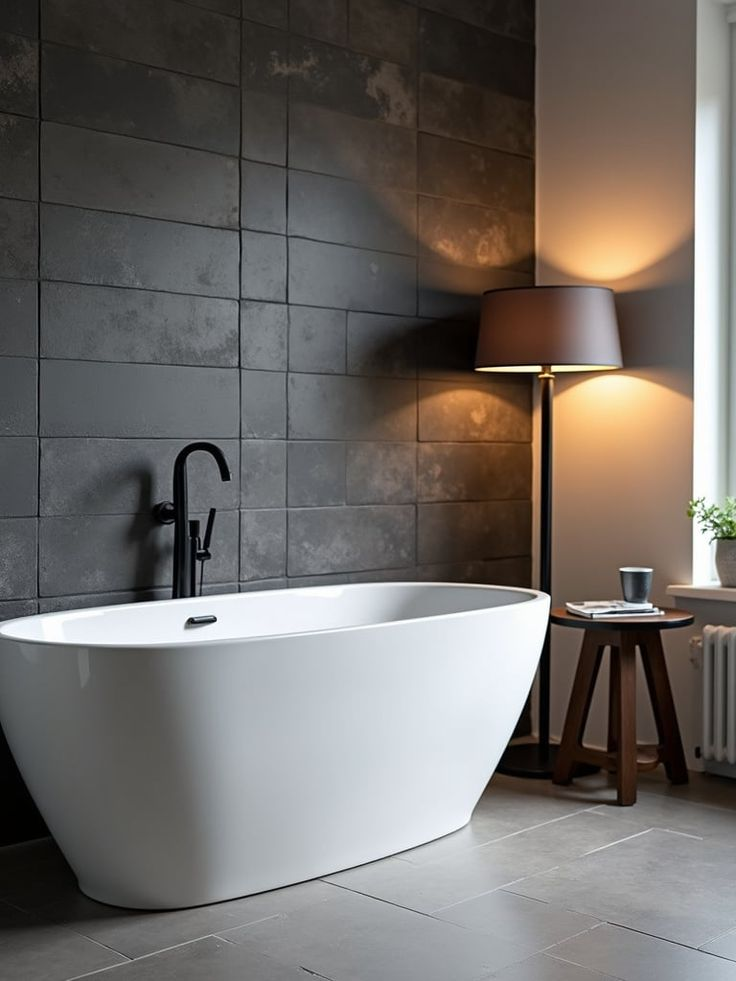
Unfinished textures and clean lines contribute to a tub wall with industrial edge. By integrating elements like brushed aluminum, blackened steel, or oxidized copper, bathrooms gain raw character without compromising elegance. Metal can be used in vertical strips, thin wall cladding, or behind recessed niches. Its pairing with concrete-effect tiles or matte black fixtures further enhances the rugged yet curated look. Rust-proof coatings and sealed finishes ensure these materials hold up in damp conditions while preserving their patina. Industrial-style bathrooms thrive on balance—where metal is grounded by wood, glass, or stone. Repetition in linear elements or symmetrical layouts reinforces the structural feel. For a softer interpretation, pair metals with greenery or backlighting. Whether applied as trim, full panels, or embedded grids, these accents introduce a modern loft-like feel around the tub area that speaks to both form and resilience. It’s an approach where utility meets minimalist artistry.
Greenery Integration
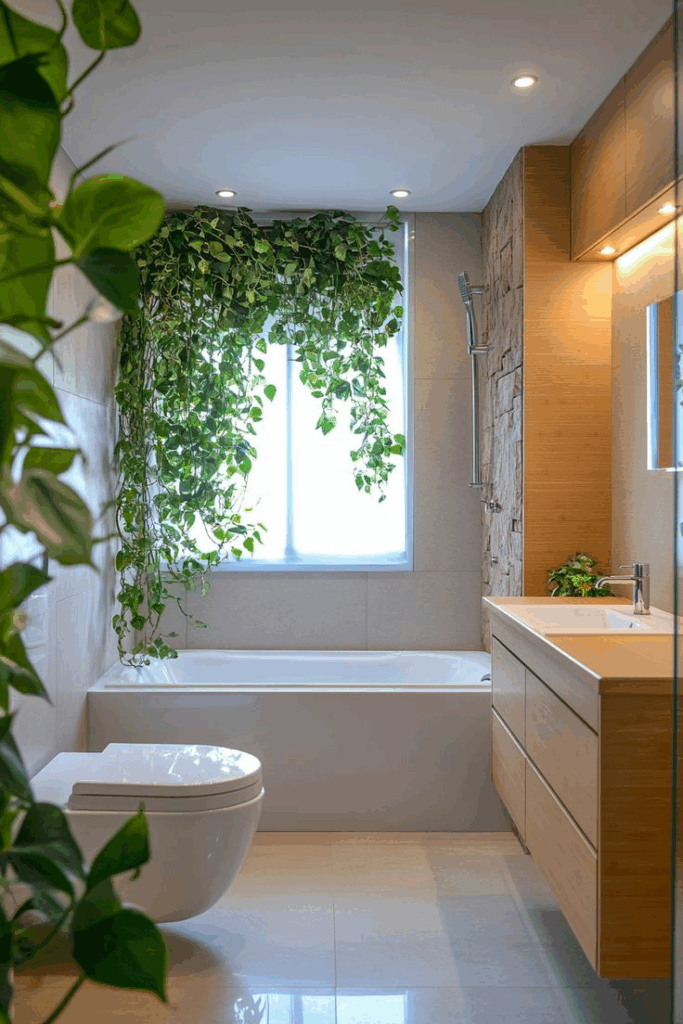
Biophilic design remains a powerful trend, and including greenery around the tub wall helps bring natural calm to a highly functional space. Living walls, mounted planters, or built-in ledges for trailing vines all infuse freshness and visual softness. Select humidity-loving plants like pothos, ferns, or philodendron that thrive in steamy environments and require little direct light. For maintenance ease, use self-watering planters or modular green wall systems designed for bathrooms. The result is an oasis-like atmosphere where the line between indoors and out begins to blur. Vertical trellises with climbing plants can also frame a tub area while doubling as a privacy feature if near a window. Even artificial greenery, when arranged thoughtfully, offers aesthetic benefits without the upkeep. Color schemes built around plant tones—think soft greens, clay tiles, and sandy neutrals—create a grounded, serene effect. These organic additions invite a sense of wellness without interrupting the room’s clean flow.
Geometric Tile Patterns
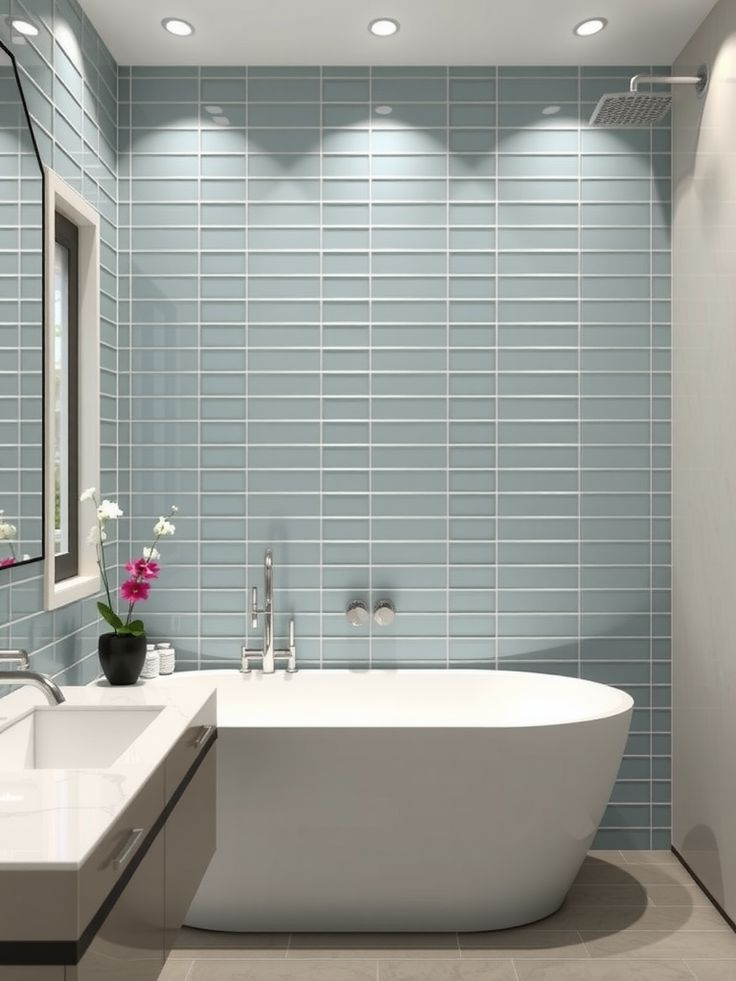
Angular precision and repetition can bring unexpected flair to the tub wall through geometric tile layouts. Hexagons, herringbone, chevrons, or triangles offer more than decoration—they add structure and modern rhythm to the bathing area. By playing with grout color or tile direction, designers can emphasize or soften the visual impact. Small patterns create intricate focal points, while oversized formats deliver bold simplicity. Whether using subtle tonal variations or contrasting black and white, geometric tiles contribute both motion and order to the wall. Suitable for contemporary, Art Deco, or even Scandinavian-inspired bathrooms, this approach works across full wall coverings or insets. The key to success lies in alignment—imprecise lines quickly look chaotic. Hiring a skilled tile installer ensures clean geometry and a crisp finish. Used strategically, geometric tile becomes the central visual language of the bathroom, guiding both the eye and the style direction from the moment you step in.
Color-Blocked Sections
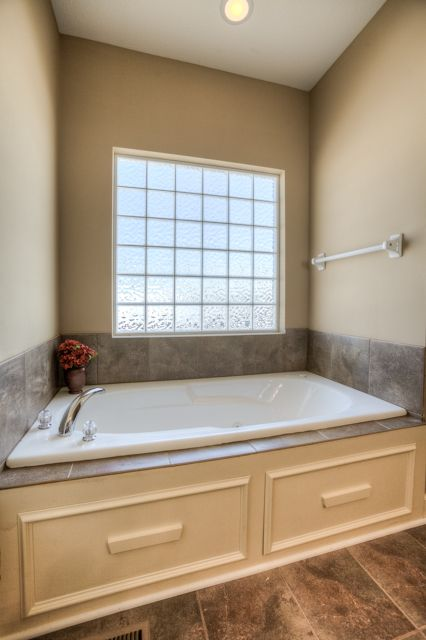
Dividing the tub wall into intentional zones of contrasting or complementary color creates visual structure and breaks up monotony. Color blocking doesn’t require multiple materials—simple shifts in tile color or paint tone can achieve the effect. Vertical blocks elongate the space, while horizontal ones stretch it visually, making this method particularly effective in bathrooms with challenging proportions. Some homeowners use tile on the lower half of the wall and paint above, while others alternate colored tile bands for a bolder impact. Keeping a common thread—like matching grout lines or unifying fixtures—ensures cohesion even amid strong contrast. Color choices should be intentional: soft neutrals for subtle separation or jewel tones for high drama. When done thoughtfully, this design style adds contemporary flair and a tailored, editorial edge to the space. Beyond pure aesthetics, color blocking guides the eye and creates a curated tub area that feels structured, intentional, and beautifully bold.
